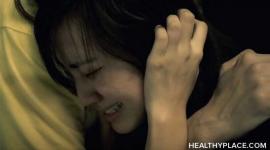What is Trichotillomania (Hair-Pulling Disorder)

What is the definition of trichotillomania? What does this hair pulling disorder look like?
Lately, you've noticed hair pulling behavior in yourself (or a loved one) and it's causing concern. Lately, you have an urge or fascination with pulling out strands of your own hair. It could be the hair on your head, your eyebrows, eyelashes or anywhere else on your body. Moments of anxiety lead to this urge and relief only comes after you have done it. What could this behavior mean? Does it have a name? Experts have recognized and named this hair pulling disorder as trichotillomania.
Trichotillomania – A Serious Mental Condition
Although the name sounds strange and is hard to spell, trichotillomania is not a laughing matter, especially for those who have it. (Learn about the effects of pulling out hair.) The term, trichotillomania represents a serious mental disorder. Specifically, mental health professionals describe it as a sort of impulse control disorder consisting of pulling hair from any part of the body including the scalp, eyebrows, eyelashes, beard, chest, pubic area, arms and legs. (What causes trichotillomania?)
This condition represents body-focused repetitive behaviors (BFRBs), such as skin picking (excoriation), nail biting, and biting of the insides of one's cheeks that can lead to physical and emotional harm.
The Diagnostics and Statistical Manual for Mental Health, Fifth Edition (DSM-V), lists trichotillomania in the new chapter entitled Obsessive-Compulsive and Related Disorders. Although it was also included as a disorder in the DSM-IV, the DSM-V has added the term "hair pulling disorder" as a parenthetical detail to its name.
Hair Pulling Disorder Leads To Bigger Problems
This hair pulling disorder can start small, but eventually blooms into a life altering hair pulling disease. You may have seen girls twisting their hair with their fingers, from nerves, concentration, or even while flirting, but the urge to actually pull strands out in order to feel relief from anxiety can develop into this serious mental condition.
Patients, predominantly female adults, describe a tenseness that leads up to the strong desire to pull out their hair. Once the patient acts on the impulse, he or she feels relief or even pleasure. The act of hair pulling then becomes a habit in order to feel this sense of relief or pleasure again and again.
Unfortunately, the repeated action of pulling out one's own hair can create further problems. Not surprisingly, a bald area can develop where the plucking occurs. Inflammation, infection, skin damage and permanent hair loss can also result from compulsive hair pulling.
Another offshoot from this disorder is trichophagia, or eating the hair. The physical complications from this are nausea, weight loss, vomiting, intestinal obstruction, and death.
Most of the physical complications of trichotillomania can often lead to emotional ones. The patient eventually suffers from lowered self-esteem and social isolation resulting from the physical damage and embarrassment surrounding the condition. In an attempt to avoid discovery, the patient feels he or she must hide the disfigurement that trichotillomania causes. They typically achieve this by avoiding people altogether - causing relationships and job performance to suffer. Left untreated, trichotillomania can lead to clinical depression.
Reading the Signs of Trichotillomania
Although patients often deny the existence of their trichotillomania, you can look for a few strong signs of the disorder. Patchy eyebrows or sparse eyelashes are visible clues, as well as bald or thin patches on the scalp, especially in persons too young for typical pattern baldness.
The disturbing habit of chewing, eating, or playing with pulled out hair represents a red flag, as well. However, the most telltale sign that you, or a loved one, may have this condition involves feeling a strong urge to repeatedly pull out hair, feeling tenseness just before doing it and feeling a sense of pleasure or relief afterwards. If you or someone close to you is exhibiting any of these symptoms, seek professional assistance. A combination of psychotherapy and medication can help alleviate the suffering. You can read more about trichotillomania treatment and how to stop pullling out hair here.
APA Reference
Gluck, S.
(2022, January 10). What is Trichotillomania (Hair-Pulling Disorder), HealthyPlace. Retrieved
on 2025, April 20 from https://www.healthyplace.com/ocd-related-disorders/trichotillomania/what-is-trichotillomania-hair-pulling-disorder




